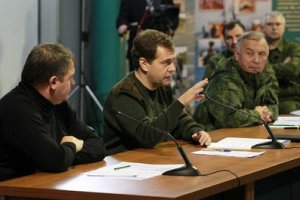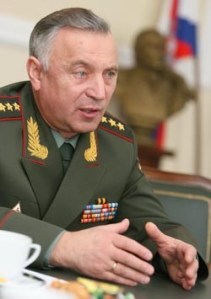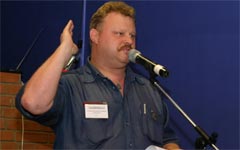General Staff Chief Makarov’s recent death pronouncement for contract service means, as he said, more conscripts in the near future (or an attempt to conscript more soldiers).
In the longer run, however, the collapse of contract service means the Russian Army faces several manpower policy choices, each unpalatable for its own reasons. The army will likely be less combat ready, and less combat capable, than desired.
Think back about where the army’s been, and how it reached the current predicament.
The armed forces were reportedly 1.13 million men, but probably more, in recent years. At any moment, they had four distinct draft contingents of about 130,000 conscripts, totaling 520,000 draftees. Next, they had a layer of perhaps 300,000 contractees and warrant officers. The contractees included probably 90,000 long-term enlisted, NCOs, and females as well as no more than 80,000 contract soldiers from 2002 and later. There were probably about 130,000 warrants.
So, let’s count 520,000 conscripts and the middle layer of 300,000, for a total of 820,000. Lastly, on top, let’s add nearly 400,000 officers.
What did this manpower structure mean for the Russian Army’s force structure?
With practically the same number of conscripts and officers, the force structure was hollow–few units or formations were fully manned and many low-strength (cadre) units had officers and equipment, but only small numbers of soldiers–conscript or contract–and they existed only to be fleshed out with mobilized reservists in the unlikely event of a big war.
This structure didn’t work well in little wars like Chechnya or more recently Georgia in which the army had to piece together regiments by finding combat ready battalions and capable commanders wherever they could be found.
In 2006, Putin said of the military dilemma at the outset of the second Chechen war:
“. . . we needed to gather a force of at least 65,000 men. And yet the in all of the Ground Troops there were only 55,000 in combat ready units, and even they were scattered all around the country. The army was 1.4 million strong, but there was no one to do the fighting. And so unseasoned lads were sent to face the bullets.”
And in late 2008, Medvedev emphasized the need for 100 percent combat ready units as the number one lesson of the August conflict over South Ossetia:
“Overall, these changes aim to make the Armed Forces more combat ready. We talked about the war in the Caucasus, where our armed forces demonstrated their best qualities, but this does not mean that there were not also problems that became apparent. We need to continue improving our Armed Forces. What steps does this require? First, we need to move over to a system of service only in permanent combat ready units.”
So, after the August war with Georgia, Serdyukov moved to eliminate the huge, big-war mobilization base, hollow units, and unneeded officers, and to use the savings to man and outfit 85 Ground Troops brigades in a permanently combat ready condition.
Given a nominal strength of 3,000 men in them, the army needs roughly 260,000 troops to man these new combat brigades. And this doesn’t count conscripts needed elsewhere in the Ground Troops, Rear Services, VVS, VMF, RVSN, VDV, or KV.
With the commencement of the one-year draft in 2008, Moscow doubled its induction of conscripts from 130,000 to 270,000 every six months. And the Ground Troops need fully half the 540,000 conscripts present in the armed forces at any given moment.
Like any country, Russia has a real and an ideal army, the army it has and the army it wants (a la Rumsfeld). Moscow’s ideal army by 2012 has one million men, including 150,000 officers, a layer of 64,000 professional NCOs, and conscripts as the balance, perhaps 800,000.
But the Arbat military district hasn’t articulated it this clearly for several reasons. First, shedding officers and (warrants) year after year isn’t an easy task. Second, the number of professional NCOs desired or available in the future is in doubt given General Staff Chief Makarov’s and Defense Minister Serdyukov’s statements on the failure of contract service and the apparent withdrawal of funding for the current contract sergeants program. And third, it’s unclear if Moscow can draft 400,000 young men semiannually to put 800,000 soldiers in the ranks.
The army Russia has is messier than the vision stated above. Serdyukov says they are at 1 million already. There were a reported 355,000 officers at the outset of the current reform in late 2008. About 40,000 officer billets were vacant and 65,000 officers were released in 2009, putting them at 250,000 officers today. Serdyukov has set about the elimination of almost all warrant officers, but he hasn’t said what they’ve done in this regard yet. Let’s guess 30,000 have been dismissed, leaving 100,000 warrants. Let’s also make reasonable guesses that 60,000 recent contractees and 70,000 longer term ones remain in the troops.
So what is there? Armed forces with 540,000 conscript soldiers and about 480,000 officers, warrants, and contract enlisted. Moscow will have to revitalize its military education system to get the smaller number of quality officers needed in the future. Getting the requisite numbers of conscripts will be a challenge given the country’s well-known demographic problems which are biting hard right now. But obtaining the noncommissioned officer layer of military unit leadership is also proving difficult. The layer is presently a jumble of perhaps 230,000 warrant officers, contract sergeants, and even officers and warrants who’ve accepted downgraded positions rather than dismissal. It is not the army’s ideal, but this middle layer fulfills some functions.
With all this said, what are the Russian Army’s manpower options for the future?
If Moscow actually reduces the officer corps to 150,000 by 2012 and the contract sergeant program is not put on track, the balance of its 1 million man army could be 800,000 or 850,000 conscripts (including conscript-sergeants trained for only 3 or 6 months). Drafting 400,000-425,000 men every six months would be practically impossible. Of the current cohort of maybe 900,000 18-year-olds, maybe 300,000 can be inducted, leaving the army to find 500,000-550,000 conscripts among men who are 19-27 and have not already served, but can be difficult to induct for various reasons.
Even if manned fully, a 12-month force has to make Moscow wonder whether this mass of conscripts with this amount of training really meets its definition of a modern, combat-ready, and combat-capable army.
Reducing the manpower requirement by cutting the army’s overall size would reduce the draft burden, but it would contravene the decreed million-man army policy. There would be howls of protest that the army is too small to cover Russia’s borders (as if one million is even enough to do it).
Extending conscription back even to 18 months would ease this task considerably. Moscow could take just slightly more than the 270,000 it is conscripting now for 12 months, and by keeping them an extra six months, it could work its way up to a conscripted force of nearly 850,000 in the space of a year and a half. An increased draft term would be unpopular but Russians would swallow it. It’s not like it would lead to a Medvedev (or Putin) defeat at the polls in 2012. The real problem might be the draft’s similarity to taxes–the longer (or higher) they get, the more incentive for people to avoid them.
So that brings us back to the central point.
The way to reduce the number of conscripts needed for a million-man army, keep the draft term at 12 months, and have a reasonably well-trained and capable force is the one path that has been abandoned–developing a large and professional NCO corps that has the right material incentives to serve for a career.
The slow-to-start, small-scale, and apparently recently eviscerated Federal Goal Program to train only 64,000 professional sergeants is not enough. The current ranks 230,000 of former officers turned sergeants, warrant officers, warrants turned sergeants, contract sergeants, and enlisted contractees is a stew that could theoretically be converted to a professional NCO corps, but it would be far from easy. In terms of size, however, it’s more like what’s required to do the job, lighten the conscription load a little, and impart some professionalism to a mass, short-term draftee army, if these NCOs become professionals themselves.
What professional NCOs demand in return is pretty basic (higher than median income wages, family housing, and guaranteed off-duty time outside the garrison), but they haven’t gotten it since the most recent contract experiments began in the early 2000s. In many cases, even officers haven’t got these things. But the pay promised in the contract sergeant program (up to 35,000 rubles per month after graduation) is more like what’s needed to attract men.
The sergeant program seems to be the army they want, but the Defense Ministry appears to have pulled the financial plug on it. The flotsam and jetsam is the army they have and might be turned into something, but there’s no move in this direction as yet. Meanwhile, recall that Serdyukov’s plan for mass officer reductions was partly justified by the thinking that many officer tasks would go into the hands of capable NCOs. And as recently as the 5 March Defense Ministry collegium, Medvedev said:
“Particular attention also should go to sergeant personnel. Sergeants need to be capable, if the situation demands it, of replacing their tactical level officers.”




